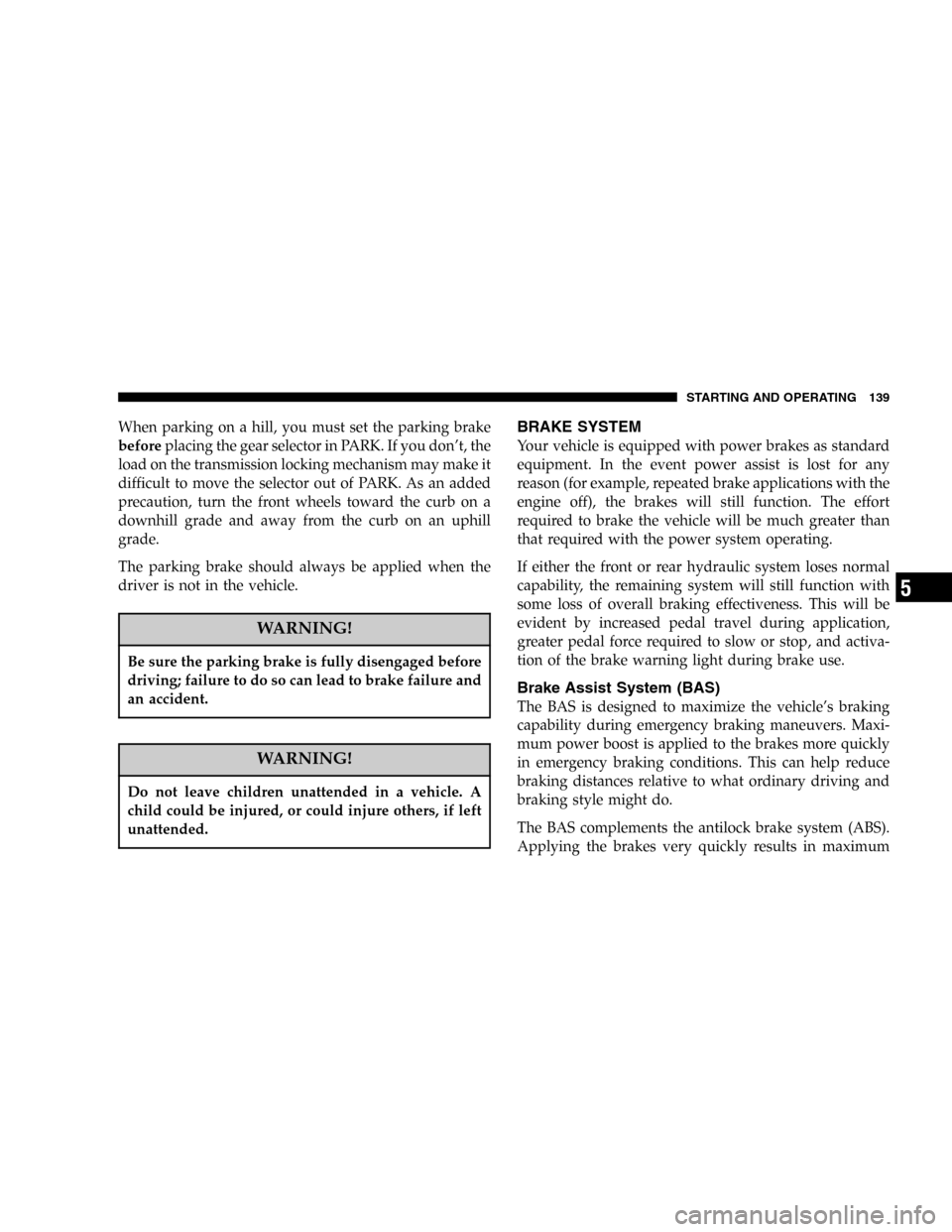2005 CHRYSLER CROSSFIRE SRT brake light
[x] Cancel search: brake lightPage 139 of 280

When parking on a hill, you must set the parking brake
beforeplacing the gear selector in PARK. If you don’t, the
load on the transmission locking mechanism may make it
difficult to move the selector out of PARK. As an added
precaution, turn the front wheels toward the curb on a
downhill grade and away from the curb on an uphill
grade.
The parking brake should always be applied when the
driver is not in the vehicle.
WARNING!
Be sure the parking brake is fully disengaged before
driving; failure to do so can lead to brake failure and
an accident.
WARNING!
Do not leave children unattended in a vehicle. A
child could be injured, or could injure others, if left
unattended.
BRAKE SYSTEM
Your vehicle is equipped with power brakes as standard
equipment. In the event power assist is lost for any
reason (for example, repeated brake applications with the
engine off), the brakes will still function. The effort
required to brake the vehicle will be much greater than
that required with the power system operating.
If either the front or rear hydraulic system loses normal
capability, the remaining system will still function with
some loss of overall braking effectiveness. This will be
evident by increased pedal travel during application,
greater pedal force required to slow or stop, and activa-
tion of the brake warning light during brake use.
Brake Assist System (BAS)
The BAS is designed to maximize the vehicle’s braking
capability during emergency braking maneuvers. Maxi-
mum power boost is applied to the brakes more quickly
in emergency braking conditions. This can help reduce
braking distances relative to what ordinary driving and
braking style might do.
The BAS complements the antilock brake system (ABS).
Applying the brakes very quickly results in maximum
STARTING AND OPERATING 139
5
Page 140 of 280

BAS assistance. To receive the benefit of the system you
must apply continuous, full braking power during the
stopping sequence. Do not reduce brake pedal pressure.
WARNING!
BAS cannot prevent the natural laws of physics from
acting on the vehicle, nor can it increase braking
efficiency beyond that afforded by the condition of
the vehicle brakes and tires or the traction afforded.
The BAS cannot prevent accidents, including those
resulting from excessive speed in turns, following
another vehicle too closely, or hydroplaning. Only a
safe, attentive, and skillful driver can prevent acci-
dents. The capabilities of a BAS-equipped vehicle
must never be exploited in a reckless or dangerous
manner which could jeopardize the user’s safety or
the safety of others.
Once the brake pedal is released, the BAS is deactivated.The malfunction indicator light for the BAS is combined
with the Electronic Stability Program (ESP) malfunction
indicator light.
The BAS/ESP malfunction indicator light in the instru-
ment cluster comes on with the key in the ignition switch
turned to the ON/RUN position and should go out with
the engine running. If the BAS/ESP malfunction indica-
tor light comes on steadily while the engine is running, a
malfunction has been detected in either the BAS or ESP
140 STARTING AND OPERATING
Page 141 of 280

system. As a result, it is possible that only partial engine
output will be available, and pressing the accelerator
pedal will require more effort.
If the BAS malfunctions, the brake system functions in
the usual manner, but without BAS.
With the ABS malfunctioning, the BAS and ESP will be
disabled. In this condition, both malfunction indicator
lights come on while the engine is running. If the
malfunction indicator light stays illuminated, have the
BAS and ESP checked at your authorized dealer as soon
as possible.
Electronic Stability Program (ESP)
The ESP enhances directional control and reduces wheel-
spin under various driving conditions. When ESP is
active, engine torque is limited and the ESP warning light
starts to flash.In winter operation, the effectiveness of the ESP can be
enhanced by equipping the vehicle with DaimlerChrysler
recommended mud and snow (M+S) rated radial-ply
tires and/or snow chains.
STARTING AND OPERATING 141
5
Page 142 of 280

WARNING!
ESP cannot prevent the natural laws of physics from
acting on the vehicle, nor can it increase the traction
afforded. The ESP cannot prevent accidents, includ-
ing those resulting from excessive speed in turns, or
hydroplaning. Only a safe, attentive, and skillful
driver can prevent accidents. The capabilities of an
ESP equipped vehicle must never be exploited in a
reckless or dangerous manner which could jeopar-
dize the user’s safety or the safety of others.
The ESP warning light starts to flash at any vehicle speed
as soon as the tires lose traction and the wheels begin to
spin.
If the ESP warning light flashes during acceleration, ease
up on the accelerator and apply as little throttle as
possible. While driving, adapt your speed to the prevail-
ing road conditions.
CAUTION!
If the vehicle is towed with the front axle raised (see
the What To Do In Emergencies section in this
manual), the engine must be shut off (key in the
ignition switch turned to the OFF/LOCK or ACC
position). Otherwise, the ESP will immediately be
engaged and will apply the rear wheel brakes.
NOTE:When the ESP warning light is illuminated
continuously, the ESP is switched off. Adapt your speed
and driving to the prevailing road conditions.
NOTE:Avoid spinning of one drive wheel. This may
cause serious damage to the drivetrain which is not
covered by the DaimlerChrysler Limited Warranty.
NOTE:If the ESP warning light flashes during accel-
eration, ease up on the accelerator.
NOTE:ESP should not be switched off during normal
driving. Disabling of the system under normal operating
conditions will eliminate the benefits of the ESP system.
142 STARTING AND OPERATING
Page 144 of 280

illuminated. With the ESP system switched off, the en-
gine torque reduction feature is cancelled. Therefore, the
enhanced vehicle stability offered by ESP is unavailable.
CAUTION!
Snow chains should never be used without the
recommended mud and snow (M+S) rated radial-ply
tires. Damage to your vehicle may result from such
usage.
ESP always operates under braking, even with the switch
in the OFF position.
If one drive wheel loses traction and begins to spin, the
ESP system will apply the brake at the affected wheel
until the wheel regains sufficient traction. The traction
control engages at approximately 24 mph (40 km/h), and
switches off at 50 mph (80 km/h).
To return to the enhanced vehicle stability offered by ESP,
press the lower half of the switch (the ESP warning light
goes out).
Anti-Lock Brake System (ABS)
The ABS gives increased vehicle stability and brake
performance under most braking conditions. The system
automatically“pumps”the brakes during severe braking
conditions to prevent wheel lock-up. The system operates
to prevent wheel lock-up and help avoid skidding on
slippery surfaces.
NOTE:The ABS improves steering control of the ve-
hicle during hard braking maneuvers.
The ABS prevents the wheels from locking up above a
vehicle speed of approximately 5 mph (8 km/h)
independent of road surface conditions.
At the instant one of the wheels is about to lock up, a
slight pulsation can be felt in the brake pedal, indicat-
ing that the ABS is in the regulating mode.
Keep firm and steady pressure on the brake pedal
while experiencing the pulsation. Continuous, steady
brake pedal pressure results in optimal braking power
while maintaining the ability to steer the vehicle.
144 STARTING AND OPERATING
Page 145 of 280

In the case of an emergency brake maneuver, keep
continuous full pressure on the brake pedal. In this
manner only can the ABS be most effective.
On slippery road surfaces, the ABS will respond even
with light brake pedal pressure because of the in-
creased likelihood of locking wheels. The pulsating
brake pedal can be an indication of hazardous road
conditions and functions as a reminder to take extra
care while driving.
WARNING!
Significant over- or under-inflation of tires, or mix-
ing sizes of front or rear tires or wheels on the
vehicle can reduce braking effectiveness. Maintain
proper tire pressure and always use the tires and
wheels specified in this manual for your vehicle.
The anti-lock brake system conducts a low-speed self-test
at about 12 mph (20 km/h). If you have your foot lightly
on the brake while this test is occurring, you may feel
slight pedal movement. The movement can be moreapparent on ice and snow. The anti-lock brake system
pump motor makes a low humming noise during opera-
tion, which is normal.
WARNING!
Pumping of the brake pedal will diminish the effec-
tiveness of the anti-lock brakes and may lead to an
accident. Pumping makes the stopping distance
longer. Just press firmly on your brake pedal when
you need to slow down or stop.
NOTE:During severe braking conditions, a pulsing
sensation may occur and a clicking noise will be heard.
This is normal, indicating that the anti-lock brake system
is functioning.
The ABS malfunction indicator light in the instrument
cluster comes on with the key in the ignition switch
turned to the ON/RUN position, and should go out with
the engine running. If the ABS light does not illuminate
STARTING AND OPERATING 145
5
Page 146 of 280

briefly during this procedure, or remains on after the
engine is running, have the system checked by an autho-
rized dealer.
When the ABS malfunction indicator light in the instru-
ment cluster comes on while the engine is running, it
indicates that the ABS has detected a malfunction and has
switched off. In this case, the brake system functions in
the usual manner, but without antilock assistance. With
the ABS malfunctioning, the BAS and ESP are also
switched off. Both malfunction indicator lights come on
with the engine running. If the charging voltage fallsbelow 10 volts, the malfunction indicator light comes on
and the ABS is switched off. When the voltage is above
this value again, the malfunction indicator light should
go out and the ABS is operational. If the malfunction
indicator light stays illuminated, have the system
checked at your authorized dealer as soon as possible.
WARNING!
ABS cannot prevent the natural laws of physics from
acting on the vehicle, nor can it increase braking or
steering efficiency beyond that afforded by the con-
dition of the vehicle brakes and tires or the traction
afforded. The ABS cannot prevent accidents, includ-
ing those resulting from excessive speed in turns,
following another vehicle too closely, or hydroplan-
ing. Only a safe, attentive, and skillful driver can
prevent accidents. The capabilities of an ABS-
equipped vehicle must never be exploited in a reck-
less or dangerous manner which could jeopardize
the user’s safety or the safety of others.
146 STARTING AND OPERATING
Page 213 of 280

Brake Master Cylinder
The fluid level in the master cylinder should be checked
when performing under hood services, or immediately if
the brake system warning light is on.
Be sure to clean the top of the master cylinder area before
removing the cap. If necessary, add fluid to bring the
fluid level up to the requirements described on the brake
fluid reservoir. Fluid level can be expected to fall as the
brake pads wear. Brake fluid level should be checked
when pads are replaced. However, low fluid level may be
caused by a leak and a checkup may be needed.Use brake fluid approved to MB 331.0, or a DOT 4 brake
fluid with: minimum dry boiling point (ERBP) 500°F,
minimum wet boiling point (WERBP) 356°F, maximum
viscosity 1500 mm
2/s, conforming to FMVSS 116 and
ISO 4925.
WARNING!
Use of a brake fluid that may have a lower initial
boiling point or unidentified as to specification, may
result in sudden brake failure during hard pro-
longed braking. You could have an accident.
WARNING!
Use only brake fluid that has been in a tightly closed
container to avoid contamination from foreign mat-
ter. Use of contaminated fluid may result in reduced
brake performance or a sudden brake failure. You
could have an accident.
MAINTAINING YOUR VEHICLE 213
7